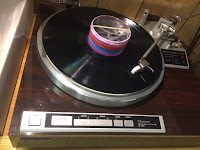Dynaco PAS 3, Part I
Overview: Dynaco
Letter from NYC (81) 2018 (7): PAS3 vs Conrad-Johnson PV-5
Dynaco PAS 3, Part II had been published (here). It dealt with all my modifications, some so unconventional that it just may surprise you.
Communication Woes I detest it when people talk loudly and incessantly on the phone in public. In HK and China, many chat loudly away in public, even in the closed confines of subway cars and buses, much to my annoyance. The US fares much better. Here I believe the telephone conversation is going the way of vinyl - that is, not dead but a minority activity. Texting is more instantaneous and in widespread use. It is almost rude to call someone, one of my friends says. As I write, a TV ad against texting while driving flashed on the screen...
Not when it comes to Audiophiles. Our long conversations tirelessly scrutinize every component and combinations. I am not the worst example, but am not completely immune. In NYC, I frequently call (though I keep them short) Andy to discuss the audio issues at hand, which is how the idea of resurrecting my Dynaco PAS 3 came about. I don't remember exactly how. I think we were talking about the Citation I and Andy reminded me that the Cathode Follower so favored by tube designers slow down the sound. The PAS 3, like our beloved Citation I, does not have one. I decided to dig out mine for a reappraisal.
"If there is one name in Hi-Fi which is synonomous with excellent sound, and at the same time with excellent price, that name is Dynaco." (from TNT)
Overview: Dynaco
- Background Read this comprehensive wikipedia entry on arguably THE most famous tube company of all time. Many people, including industrial professionals, got their first taste of tube audio from Dynaco, at a time when solid state started their domination. The HUGE amount of information and after-market products and support on the internet testify to the excellence, indeed immortality, of the products. The reader can easily search for any info on any Dynaco product, so I need not elaborate.
- Online Resources, Mods and HiFi Lore As the stuff were bargain kits without frills, mostly home-built and easily available, they were, and still are, undervalued. You know, cheap stuff, no matter how good, do not engender pride of possession, an unfortunate human trait. This leads many people to buy and modify Dynaco for fun, to satisfy their own DIY penchants and David vs Goliath mentality (whereas few would do drastic surgeries on, say, a Marantz or McIntosh). What matters more to me, however, is how perceived monetary value undermines the objective assessment of their true sonic merits. As an example, is Dynaco PAS 3 vs Marantz 7 really David vs Goliath? I think not. But many of the DIY people and mod squads buy into this line of thinking, partly because they have been taught so (for people who supposedly are thinking outside the box, many of them have a surprisingly herd mentality) and partly because many of them do not have much experience with more expensive gear nor high end audio. The internet can provide any number of instructions on how to do this and that. Aside from basic restoration, you are urged to defeat the tone control, remove the selenium rectifier, beef up the power supply, use expensive caps, improve the speed, firm up the bass, make the RIAA flatter, add stages and stand up to perceived Goliaths. All of these promise improved sound, but should you believe in all of it? Based on my experience with mods, exercise caution and restraint. I have yet to hear a wholesale mod of anything that sounds good. Also, our beliefs in Google are seriously challenged these days - it buries the small voices, much dissent, and the Google algorithm is no less commercial than advertisements as it is calculated to increase traffic and income. When you get tired of the monolithic views prevalent in most popular and most googled sites, perhaps you can search in audioreview user reviews, which offer capsular opinions that are much less didactic and more varied.
- Dynaco ST-70 This is THE most iconic product, and deservedly so. As with all Dynaco products, it is a masterclass in economy - in a relatively small footprint, we have a tube rectified (valued by many tube aficionados), adjustable bias amplifier with very good irons. Many people think the treble is too soft, but I disagree and think (given a good specimen) in this parameter it is amongst the best in EL34 amps that I have heard - there is a silken smoothness that is just mesmerizing. People also complain about the somewhat loose bass, which is also why many mods and later iterations switched to solid state rectification, but I think it is the opposite - the tube rectification makes the amp more wholesome. I think it sounds better than the Marantz 5 and gives the Marantz 8B a run for its money. In my early years in HK, I had a pair (with the later and supposedly inferior Japanese output trannies) and it produced delightful sound with a DIY Marantz 7 (constructed for me, before I took up the solder, by an audiophile student) and Rogers LS 3/5A. I still have one in NYC with the A470 trannies, which I occasionally listen to (read my report on the ST70 and 8B driving the Maggies). Maybe it is time to resurrect it in view of my PAS 3 project.
- ST 35/SCA 35 I have one of each in HK. They are wonderful examples of EL84 amps, which I prefer to EL34 amps.
- Mark III This is another classic product that offers more power than the ST-70 in small monoblock chassis. Very fine sounding if tubed right.
- FM 3 A marvelous no-frills tuner that is a sonic match for many much more well known tuners (like McIntosh). My specimen is mint and sounds great.
- PAS 3 In shocking ways, my experience with the PAS 3 pretty much parallels mine with the Harman Kardon Citation I. That is, for the longest time, I did not think much of it, but my opinion drastically changed when it was finally used with my horns, but not without struggles! Read on, as it may be a long series!
- Other Products I have no experience of the earlier products, some mono. I have heard quite a few of the solid state products and they all sounded above average. There is some good engineering behind this brand! But these are largely outside my radar.
- Panor and Later Products In the early 90's I heard in HK the Panor ST-70 Series II (in the now defunct Man Yee building), and it did not impress me, but that could be the dealer, which was not known for setup skills. It had divided opinions (panned in Stereophile but well received by TNT). If you google, you shall find out how much furor it had stirred up. I'd think that is par for the course - it takes a courageous soul to try to bring back an "updated" version of a legend. The lesson continues to the present day, right now, when Canadian company Raidial Engineering tries to bring out its Series III (here). Although publicized in trade magazines like TAS, apparently Panor, which seems to still own the trademark, had instigated lawsuits which may or may not have been settled.
Dynaco PAS 3
- Background As with many things Dynaco, there is an incredible amount of info available on the internet. For a manageable background, read radiomuseum and this article titled The Most Important Preamp in The World. The 3 and 3X are very similar and here is a good article on how to tell AS 3 from PAS 3X. My unit is a stock PAS 3.
- Round 1: Initial Impressions I am not sure how many years had elapsed since the last time I heard the PAS 3 - perhaps two decades? Hooked up to my horns, I was quite take aback. Whereas I had remembered it as slow and gray, it was now lightning fast and quite aggressive. The leading edge and transients were very exciting, but the treble was very rough and the preamp could not play loud at all, as it turned strident fast. But I knew: it has potential.
- Round 2: vs Conrad Johnson PV-5 I took it to Kevin's house (equipment more or less detailed here), where it was matched with Conrad Johnson PV-5. As expected, the PAS 3 sounded smoother here but its fast leading edge and weakness at loud volume were still very much evident. Listened at a reasonable volume the sound was very promising, very much more so than the CJ PV-5: while the CJ painted a more comforting broad stroke and bold colors, the stock PAS 3, even when tethering at the edge, revealed a much broader palette of infinite shades and hues, in both tonality and rhythm.

There is a LOT more to Part II. Stay tuned.


:format(jpeg):mode_rgb():quality(40)/discogs-images/R-3500757-1403236348-9350.jpeg.jpg)
:format(jpeg):mode_rgb():quality(40)/discogs-images/R-884932-1197513585.jpeg.jpg)

























